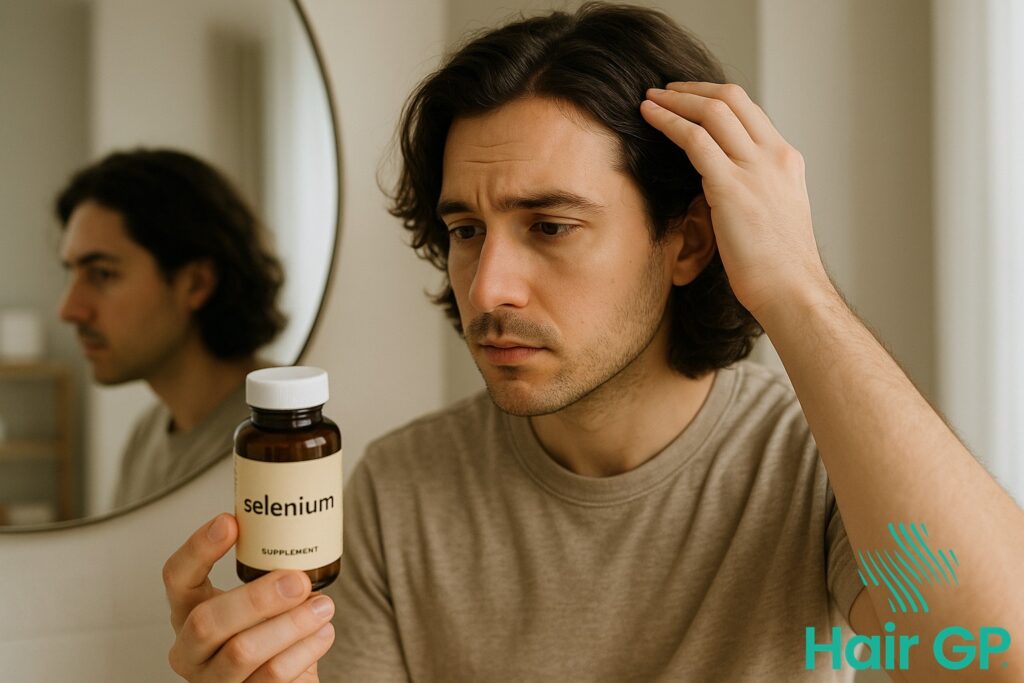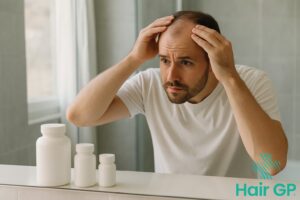Introduction
Should you take selenium for hair loss? The pros and cons of this essential mineral have sparked considerable interest amongst those seeking effective hair loss treatment options. As our understanding of nutritional influences on hair health continues to evolve, selenium has emerged as a potentially valuable player in maintaining healthy hair growth cycles.
Selenium supplements represent just one category of dietary supplements that claim to support hair follicle function and prevent excessive shedding. This trace mineral plays crucial roles in thyroid function, antioxidant protection, and cellular metabolism—all processes that directly impact the health of your hair. However, the relationship between hair loss selenium supplementation is more complex than simply taking a pill.
This comprehensive guide examines the science behind selenium’s role in hair biology, exploring how deficiency might contribute to various forms of hair loss and which individuals may be at greatest risk. We’ll analyse the evidence for selenium’s potential benefits whilst addressing critical safety concerns, as excessive intake can paradoxically cause the very problem it aims to solve. You’ll discover optimal dosage guidelines, learn how to identify the best sources of selenium, and understand when alternative approaches might be more appropriate for your specific hair loss concerns.
Key Takeaways – TL/DR
- Selenium deficiency can contribute to hair loss, but supplementation should be approached carefully
- The recommended daily selenium intake is 55 mcg for adults, with toxic effects possible above 400 mcg
- Excessive selenium intake can actually cause hair loss through selenium toxicity
- Natural food sources are safer than supplements for maintaining healthy selenium levels
- Consult a healthcare provider before taking selenium supplements for hair concerns
What Is Selenium and Its Role in Hair Health?
Selenium stands as an essential trace mineral that plays crucial roles in maintaining hair health through its powerful antioxidant properties and support of thyroid function. This micronutrient influences multiple biological processes that directly impact the hair growth cycle, making it a key consideration for those seeking to support hair growth naturally.
Essential Functions of Selenium in the Body
Selenium serves as a critical component of glutathione peroxidase, one of the body’s most important antioxidant enzymes that provides cellular protection against oxidative stress [1]. This antioxidant protection extends to hair follicles, shielding them from damage caused by free radicals that can disrupt normal hair growth patterns. Beyond its antioxidant capabilities, selenium plays an indispensable role in thyroid hormone metabolism, helping convert thyroxine (T4) into the more active triiodothyronine (T3) [2]. Since thyroid hormones directly regulate hair follicle cycling and growth, adequate selenium levels become essential for maintaining healthy hair growth. Additionally, selenium supports immune system function, helping prevent inflammatory conditions that might otherwise compromise hair follicle health.
How Selenium Supports the Hair Growth Cycle
The selenium benefits for hair extend through several mechanisms that promote optimal follicle function. Selenium facilitates protein synthesis, particularly the production of selenoproteins that protect hair follicles from oxidative damage during their active growth phase. This mineral helps regulate the anagen (growth) phase of the hair cycle, potentially extending the period during which hair actively grows. Furthermore, selenium’s role in maintaining proper thyroid function indirectly supports consistent hair growth patterns, as thyroid imbalances frequently manifest as hair loss or thinning. By providing comprehensive follicle protection and supporting the cellular processes essential for hair production, selenium emerges as a vital nutrient for those seeking to maintain robust hair health.

The Link Between Selenium Deficiency and Hair Loss
The relationship between selenium deficiency and hair loss has gained scientific attention as researchers uncover the mineral’s crucial role in maintaining healthy hair growth cycles. Whilst severe selenium deficiency remains relatively uncommon in developed nations, subclinical deficiencies may contribute to various forms of hair loss, including telogen effluvium and diffuse hair thinning [3].
Signs of Selenium Deficiency Affecting Hair
Recognising the signs of low selenium levels affecting hair health can help identify potential underlying nutritional imbalances. Brittle hair represents one of the earliest indicators, as selenium’s role in protecting hair proteins becomes compromised. Individuals may notice their hair breaking more easily and developing a rough, lifeless texture that resists styling efforts.
Increased hair shedding often accompanies selenium deficiency, with affected individuals experiencing hair fall beyond the normal 50-100 strands per day. This generalised hair loss typically manifests as overall thinning rather than patchy baldness. Slow hair growth becomes apparent as the normal growth cycle lengthens, whilst texture changes may include increased dryness and loss of natural lustre [4]. In severe cases, individuals may develop telogen effluvium, where large numbers of follicles prematurely enter the resting phase.
Who’s at Risk for Low Selenium Levels?
Geographic factors significantly influence selenium status, as soil content varies dramatically between regions. Areas with selenium-poor soil, including parts of Europe, China, and New Zealand, produce crops with lower selenium content [5]. Residents in these regions face increased risk of deficiency without dietary supplementation.
Dietary restrictions pose another risk factor, particularly for strict vegetarians and vegans who avoid selenium-rich animal products. Medical conditions affecting nutrient absorption, such as Crohn’s disease, coeliac disease, and chronic diarrhoea, can lead to severe hair loss through impaired selenium uptake. Age factors also play a role, with elderly individuals often experiencing reduced dietary intake and absorption efficiency. Additionally, those undergoing dialysis, living with HIV, or experiencing chronic gastrointestinal disorders face heightened risk of developing selenium deficiency and subsequent hair-related symptoms.

Benefits of Selenium for Hair Growth and Health
Maintaining optimal selenium levels offers numerous selenium benefits for hair health, working through multiple mechanisms to promote hair growth and prevent hair loss. Research demonstrates that adequate selenium intake helps preserve follicle function, enhances scalp circulation, and supports the body’s natural hair renewal processes[3].
Antioxidant Protection for Hair Follicles
Selenium’s powerful antioxidant properties play a vital role in protecting hair follicles from oxidative damage. As a key component of glutathione peroxidase enzymes, selenium neutralises harmful free radicals that can damage follicular cells and disrupt normal hair growth[6]. This protection is particularly important for maintaining scalp health, as oxidative stress has been linked to premature hair ageing and various hair concerns including thinning and brittleness.
The mineral’s protective effects extend to preserving the structural integrity of hair follicles, preventing cellular damage that could lead to weakened hair shafts. By reducing oxidative stress at the follicular level, selenium helps maintain the optimal environment needed to support hair health throughout all growth phases.
Supporting Healthy Hair Growth Phases
Selenium contributes significantly to maintaining normal hair growth cycles, particularly supporting the anagen (growth) phase. Adequate selenium levels help ensure follicles remain in the active growth phase for optimal duration, potentially improving hair density and reducing premature shedding. This mineral works synergistically with other nutrients to regulate cellular processes essential for hair regrowth.
Research indicates that selenium deficiency can disrupt the hair growth cycle, leading to increased telogen (resting phase) follicles and subsequent hair loss. By maintaining proper selenium levels, individuals may experience reduced hair shedding and improved overall hair quality, addressing common concerns about thinning and loss.
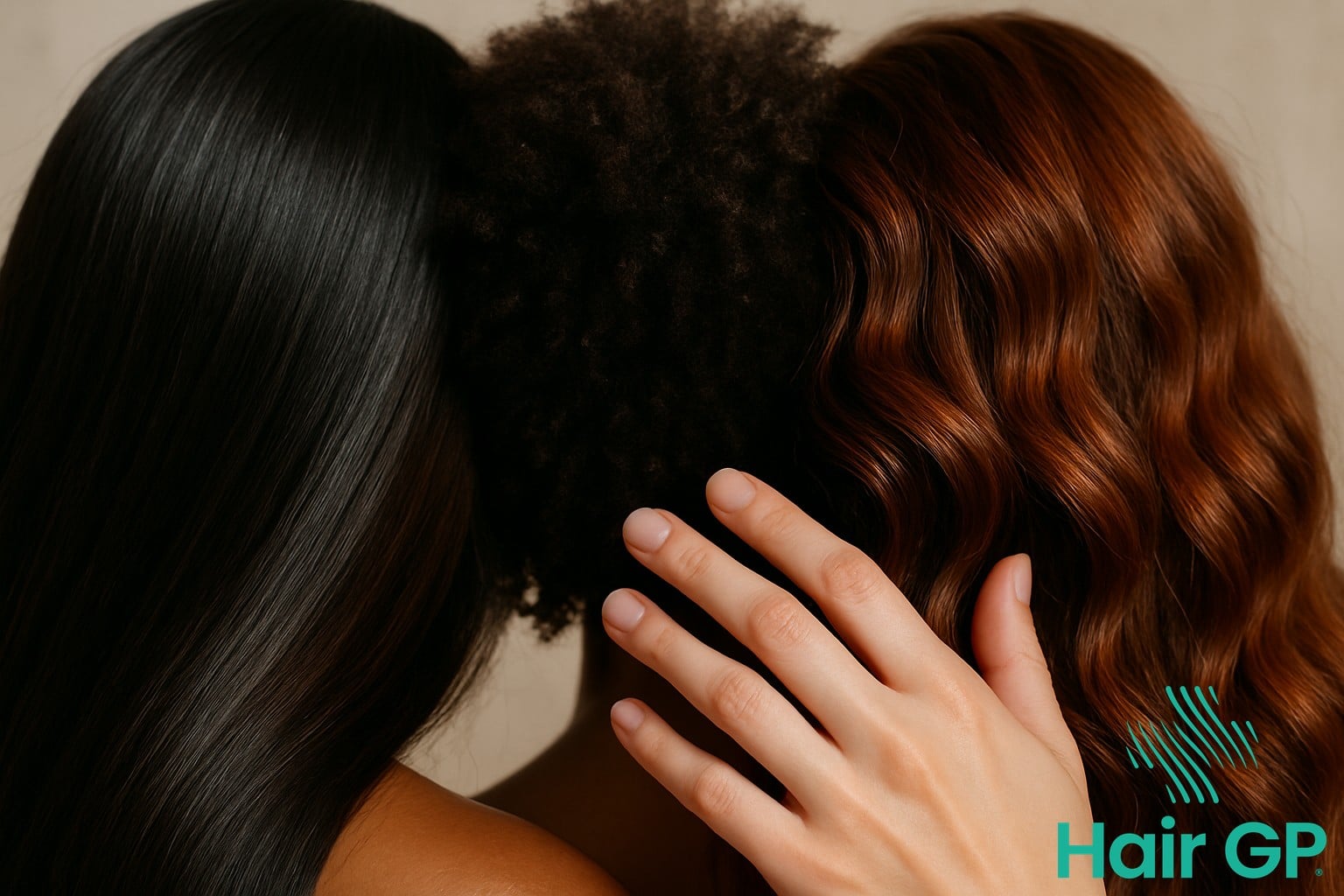
Risks and Side Effects of Excessive Selenium Intake
Whilst selenium plays a vital role in maintaining healthy hair follicles, excessive selenium intake can paradoxically trigger severe hair loss and numerous health complications. Understanding the fine line between therapeutic and toxic doses becomes crucial, as selenium toxicity can occur at levels only moderately above recommended intakes, with the tolerable upper limit set at 400 micrograms daily [7].
Symptoms of Selenium Toxicity
Selenium toxicity, known as selenosis, presents with distinctive clinical features that healthcare providers must recognise promptly. The hallmark garlic breath odour occurs as the body attempts to eliminate excess selenium through respiratory pathways [8]. Additional symptoms include nail brittleness and discolouration, often manifesting as white spots or streaks. Neurological symptoms may develop, including peripheral neuropathy, irritability, and fatigue. Paradoxically, hair loss becomes one of the most distressing symptoms when individuals develop selenium toxicity from supplements intended to promote hair growth.
How Excess Selenium Causes Hair Loss
Too much selenium damages hair follicles through oxidative stress mechanisms, disrupting the delicate growth cycle. Excessive selenium intake interferes with protein synthesis within the hair matrix, leading to structural weakness and premature follicle regression. This disruption triggers widespread telogen effluvium, where numerous follicles simultaneously enter the resting phase, resulting in diffuse hair shedding approximately two to three months after selenium overdose begins [9].
Long-term Health Risks
Beyond hair loss, chronic selenium toxicity poses serious systemic health risks. Recent epidemiological studies have linked excessive selenium levels with increased cardiovascular disease risk, particularly in populations consuming high-selenium diets [10]. Prolonged exposure may elevate type 2 diabetes risk through mechanisms involving insulin signalling disruption. Neurological damage can persist, with some individuals experiencing permanent peripheral neuropathy. These findings underscore the importance of adhering to recommended dosages and avoiding self-supplementation without professional guidance, as the therapeutic window for selenium remains remarkably narrow.
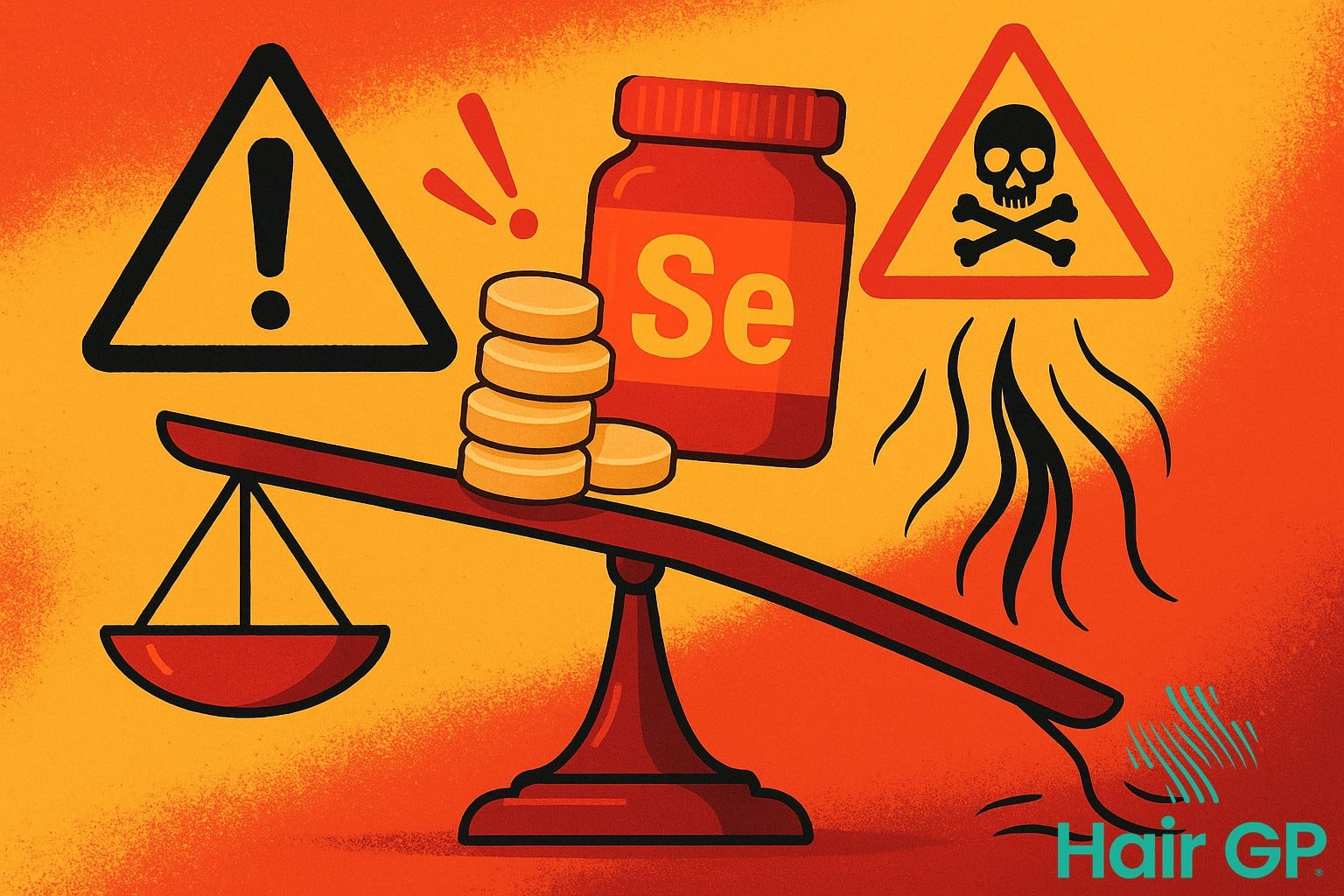
How Much Selenium Do You Need? Dosage Guidelines
Understanding how much selenium your body requires is crucial for maintaining healthy hair growth whilst avoiding toxicity. Evidence-based guidelines help determine safe daily selenium intake levels that support optimal hair health without exceeding recommended limits.
Recommended Daily Allowances by Age and Gender
The recommended selenium intake varies across different life stages and populations. Adults require 55 micrograms daily, whilst pregnant women need 60 micrograms to support both maternal and foetal health[11]. Children’s requirements range from 20 micrograms for toddlers to 40 micrograms for adolescents. The tolerable upper intake level for adults is 400 micrograms daily[11], beyond which toxicity symptoms may develop. Individuals with lower selenium intakes may experience compromised hair health, whilst excessive consumption can paradoxically cause hair loss.
Food Sources vs. Supplements
Natural food sources typically provide safer, more bioavailable selenium compared to selenium supplementation. Brazil nuts contain exceptionally high levels, with just one or two nuts providing enough selenium for daily needs. Seafood, poultry, and whole grains offer moderate amounts with better absorption rates than synthetic supplements[12]. Whilst supplements ensure consistent intake, they carry higher overdose risks. Food-based selenium binds to amino acids, enhancing absorption and reducing toxicity potential. For hair health optimisation, combining varied dietary sources proves more beneficial than relying solely on supplements, unless addressing diagnosed deficiency under medical supervision.
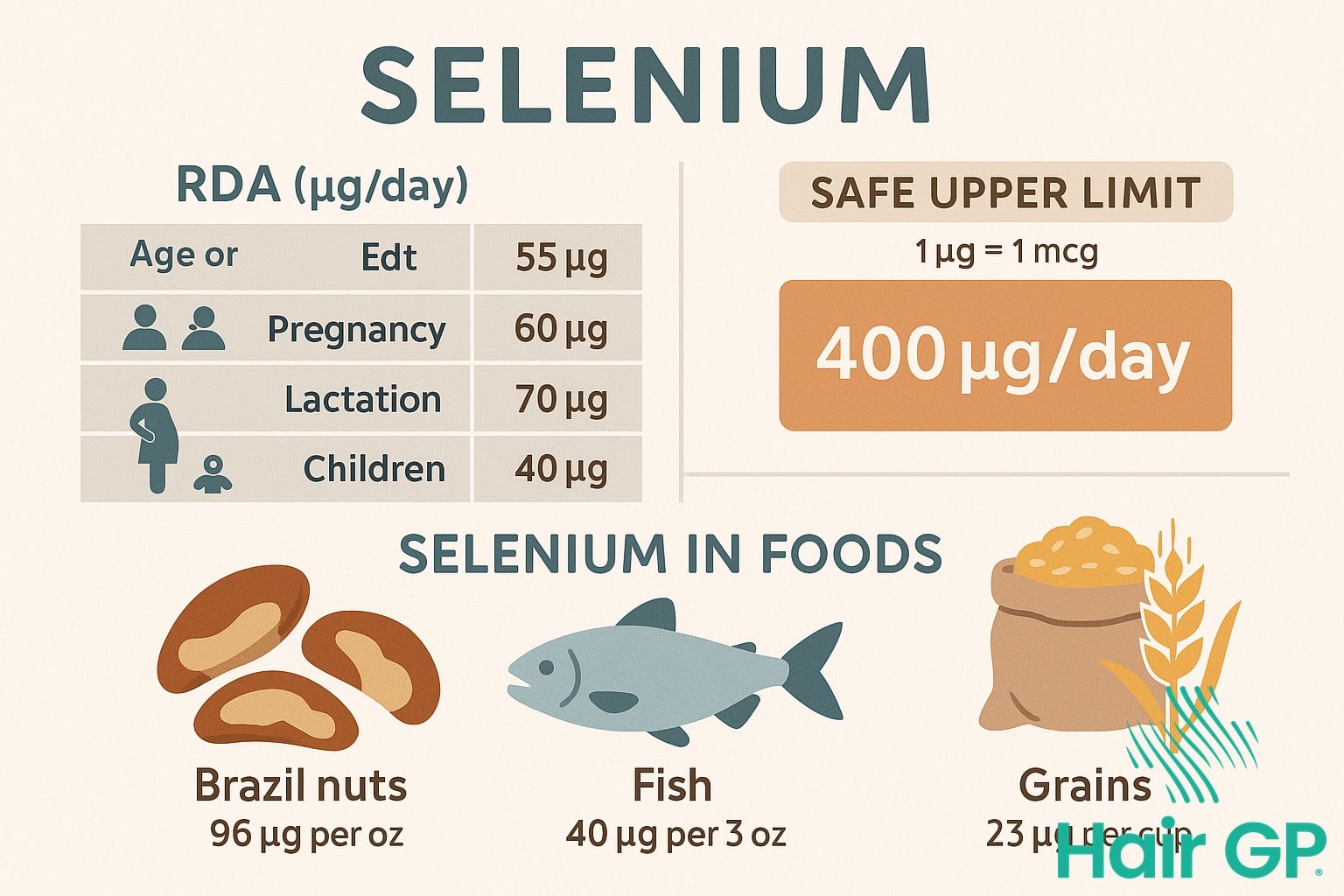
Alternative Hair Loss Treatments to Consider
Whilst selenium plays a valuable role in addressing hair problems, several other evidence-based hair loss treatment options exist. Minoxidil remains the most clinically proven topical treatment for male pattern baldness and various forms of hair thinning. Iron supplementation has shown promise for strengthening hair structure, but only when a deficiency is present. For conditions like alopecia areata, corticosteroid treatments may provide relief. Iron supplementation, laser therapy, and finasteride represent additional proven approaches. Combining these treatments with adequate selenium intake often yields better results than single interventions, offering comprehensive solutions for diverse hair loss concerns.
Conclusion
The relationship between hair loss selenium levels requires careful balance. Whilst adequate selenium levels support healthy hair growth, both deficiency and excess can trigger hair shedding. If you’re experiencing hair loss, consult a healthcare professional before taking selenium supplements, as inappropriate dosing may cause further hair loss. Professional assessment can determine whether selenium imbalance contributes to your hair concerns and guide appropriate supplementation. Remember, maintaining optimal selenium status through balanced nutrition typically provides the best foundation for hair health, whilst avoiding the risks associated with excessive supplementation.
Frequently Asked Questions
Selenium supplements may help regrow hair only if hair loss was caused by selenium deficiency. They won’t reverse genetic pattern baldness or other non-nutritional causes of hair loss. Always confirm deficiency through blood tests before supplementing.
If selenium deficiency was causing hair loss, improvements typically appear within 3-6 months of correcting the deficiency. However, hair growth is a slow process, and full results may take up to a year.
Brazil nuts are the richest source (just 1-2 nuts meet daily needs), followed by seafood, organ meats, whole grains, and eggs. Food sources are generally safer than supplements as they’re less likely to cause toxicity.
Selenium generally doesn’t interact with topical treatments like minoxidil. However, it can interact with certain medications and other supplements. Always inform your healthcare provider about all supplements you’re taking.
References
- Barayuga SM, Pang X, Andres MA, Panee J, Bellinger FP. Methamphetamine decreases levels of glutathione peroxidases 1 and 4 in SH-SY5Y neuronal cells: protective effects of selenium. Neurotoxicology. 2013. PMID: 23721877
- Köhrle J. Selenium and the thyroid. Curr Opin Endocrinol Diabetes Obes. 2015. PMID: 26313901
- Almohanna HM, Ahmed AA, Tsatalis JP, Tosti A. The Role of Vitamins and Minerals in Hair Loss: A Review. Dermatol Ther (Heidelb). 2019. PMID: 30547302
- Guo EL, Katta R. Diet and hair loss: effects of nutrient deficiency and supplement use. Dermatol Pract Concept. 2017. PMID: 28243487
- Rayman MP. Selenium and human health. Lancet. 2012. PMID: 22381456
- Trüeb RM. Oxidative stress and its impact on skin, scalp and hair. Int J Cosmet Sci. 2021. PMID: 34424547
- Vinceti M, Filippini T, Cilloni S, Bargellini A, Vergoni AV, Tsatsakis A et al.. Health risk assessment of environmental selenium: Emerging evidence and challenges (Review). Mol Med Rep. 2017. PMID: 28339083
- Ashar BH. The dietary supplement health and education act: time for a reassessment: comment on "acute selenium toxicity associated with a dietary supplement". Arch Intern Med. 2010. PMID: 20142571
- Sengupta A, Lichti UF, Carlson BA, Ryscavage AO, Gladyshev VN, Yuspa SH et al.. Selenoproteins are essential for proper keratinocyte function and skin development. PLoS One. 2010. PMID: 20805887
- Rayman MP. Selenium intake, status, and health: a complex relationship. Hormones (Athens). 2020. PMID: 31388899
- Kipp AP, Strohm D, Brigelius-Flohé R, Schomburg L, Bechthold A, Leschik-Bonnet E et al.. Revised reference values for selenium intake. J Trace Elem Med Biol. 2015. PMID: 26302929
- Ferreira RLU, Sena-Evangelista KCM, de Azevedo EP, Pinheiro FI, Cobucci RN, Pedrosa LFC. Selenium in Human Health and Gut Microflora: Bioavailability of Selenocompounds and Relationship With Diseases. Front Nutr. 2021. PMID: 34150830

